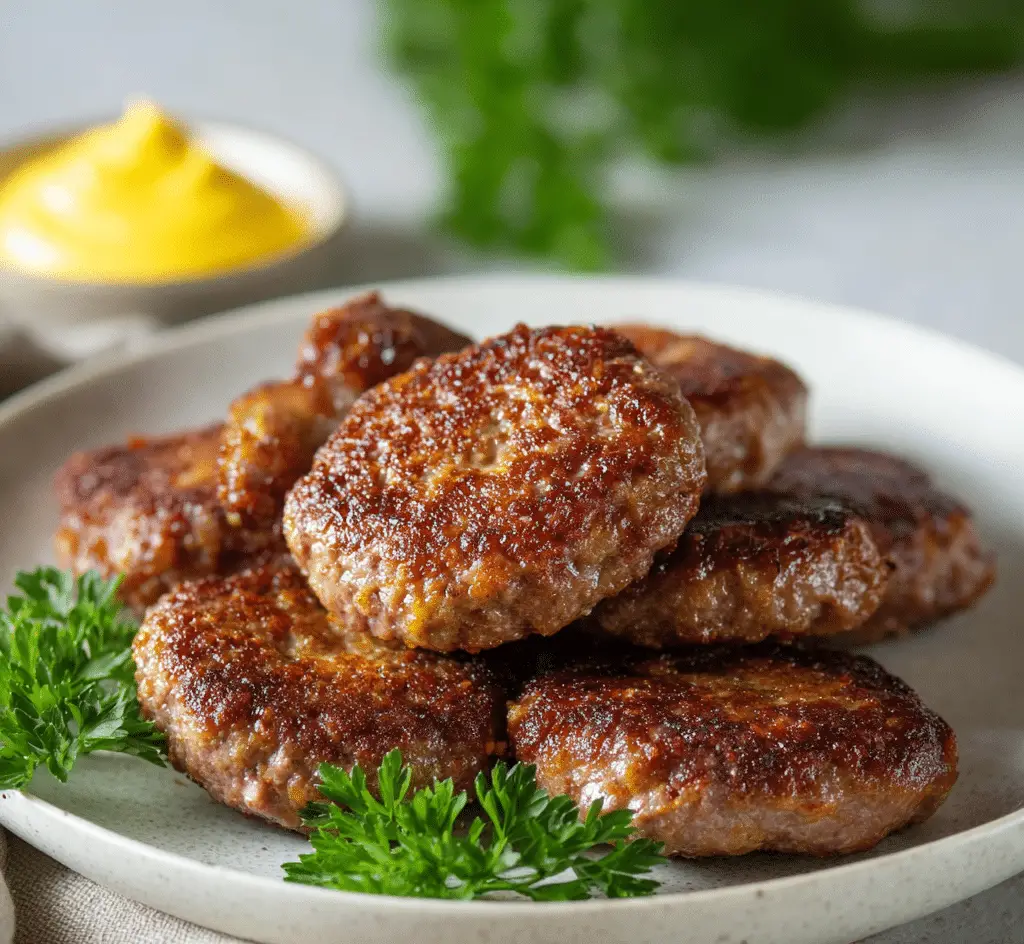These classic German Frikadellen are a beloved comfort food that brings hearty satisfaction to any meal. Think of them as the German cousin to meatballs or hamburger patties—packed with flavor, pan-fried to perfection, and made with simple, wholesome ingredients.
Perfect for a weeknight dinner or family gathering, Frikadellen are incredibly versatile. Serve them hot with a dollop of mustard, a generous helping of mashed potatoes, or a refreshing side salad. Whether you’re embracing your German roots or just exploring new cuisines, this dish is a guaranteed crowd-pleaser.
Full Recipe
Ingredients:
-
500g ground beef (or half pork, half beef)
-
1 onion, finely chopped
-
1 egg
-
1 slice white bread (soaked in water, then squeezed out)
-
1 tsp German mustard (or Dijon)
-
1 tsp salt
-
½ tsp black pepper
-
1 tsp sweet paprika
-
1 tbsp chopped parsley (optional)
-
2–3 tbsp oil or butter for frying
Directions:
-
In a large mixing bowl, combine the ground meat, chopped onion, egg, soaked bread, mustard, salt, pepper, paprika, and parsley.
-
Mix the ingredients thoroughly by hand or with a spoon until well combined.
-
Shape the mixture into 6–8 patties, each about the size of your palm.
-
Heat oil or butter in a skillet over medium heat.
-
Fry the Frikadellen on each side for 5–6 minutes, or until golden brown and cooked through.
-
Serve warm with mustard, mashed potatoes, or a side salad.
Prep Time: 10 minutes | Cooking Time: 12 minutes | Total Time: 22 minutes
Kcal: 280 kcal per patty (approx.) | Servings: 6–8 patties
What Are Frikadellen?
Frikadellen are traditional German meat patties that fall somewhere between a hamburger and a meatball in texture and preparation. While their appearance may resemble burgers, the flavor is far richer and more savory, often due to the inclusion of finely chopped onions, soaked bread, mustard, and aromatic spices. These juicy, pan-fried patties have long held a place in German home kitchens and street food stalls alike, prized for their simplicity, adaptability, and bold taste.
The word “Frikadelle” can be traced back to several European languages, including French (“fricadelle”) and Dutch (“frikadel”). The dish’s concept—minced meat mixed with various binders and seasonings—has traveled across cultures, with every region making its own delicious variation. In Germany, however, Frikadellen stand on their own as an iconic comfort food.
The History and Cultural Significance of Frikadellen
Frikadellen have been a staple of German cuisine for centuries, especially in the northern and central parts of the country. Traditionally, they were a way to make the most of leftover meat, especially during lean times. Families would grind up small pieces of beef or pork and mix them with bread, onions, and eggs to create a nourishing, filling meal.
In modern German culture, Frikadellen are commonly enjoyed both at home and in public settings. You’ll find them in bakeries, cafés, and even gas stations throughout Germany, where they’re often served in a crusty bread roll with mustard—what many refer to as the German equivalent of a fast-food burger. At home, they’re a beloved part of everyday meals, especially popular among families because of how kid-friendly and budget-conscious they are.
During festivals, potlucks, and family gatherings, Frikadellen are commonly served as appetizers or part of a larger hot meal. Their enduring presence in both casual and festive dining shows just how deeply embedded they are in Germany’s culinary identity.
What Makes Frikadellen Unique
Unlike American-style hamburgers that focus on the beef itself, Frikadellen elevate the entire blend of ingredients into a well-balanced, flavorful bite. Moisture and softness are achieved through the addition of soaked bread (instead of breadcrumbs), while finely chopped onions contribute sweetness and texture.
Another distinguishing factor is the seasoning. German mustard, sweet paprika, and parsley add nuanced depth, giving Frikadellen a subtle but unmistakable European flavor profile. They are gently pan-fried rather than grilled, which creates a beautifully browned crust while locking in moisture. The result is a patty that is juicy on the inside, golden and slightly crispy on the outside, and deeply satisfying in every bite.
Variations and Regional Differences
Although the basic concept of Frikadellen remains the same across Germany, slight variations exist depending on the region or household traditions. In Bavaria, for instance, they might be made with a higher pork content and sometimes feature caraway seeds for an earthy note. Northern German Frikadellen may incorporate marjoram or nutmeg for added aroma. Some versions even add grated potatoes for an extra tender texture.
Modern interpretations of the dish have also opened the door for international influences. For example, a Mediterranean version may incorporate olives and sun-dried tomatoes, while others swap out the beef for turkey or chicken to make the patties lighter. Plant-based versions are also increasingly common, using lentils, mushrooms, or plant-based meat substitutes, making the dish more inclusive and environmentally conscious.
How to Serve Frikadellen
Frikadellen are versatile and can be served in a variety of delicious ways. The most traditional accompaniments include creamy mashed potatoes, warm potato salad, sauerkraut, or steamed vegetables. A drizzle of German mustard or a dollop of sour cream is often all that’s needed to elevate the flavor even more.
For a more casual presentation, many Germans enjoy Frikadellen tucked into a crusty bread roll, similar to a sandwich or burger. Add lettuce, pickles, or a smear of remoulade for an easy grab-and-go meal.
They also make fantastic picnic food or party appetizers, especially when served cold with dipping sauces like aioli or herb yogurt. Their flavor doesn’t diminish when cooled, making them a practical option for meal prep, packed lunches, and potluck spreads.
Health Considerations and Nutritional Info
Frikadellen are a protein-rich dish that provides good sustenance and satiety, especially when paired with fiber-rich sides like vegetables or whole grains. While traditional recipes use a mix of pork and beef, leaner versions using only beef, chicken, or turkey can help reduce fat content.
The inclusion of onions and parsley brings additional antioxidants and vitamins, and using soaked bread rather than breadcrumbs keeps the texture light without added sodium or preservatives. Pan-frying in olive oil or butter provides a balanced method of cooking that allows for browning without the need for deep-frying.
As with all meat-based dishes, moderation is key, especially if you’re watching cholesterol or saturated fat intake. That said, Frikadellen can certainly fit into a balanced diet when made thoughtfully.
Tips for Perfect Frikadellen Every Time
-
Use fresh ingredients: Freshly ground meat and finely chopped onions will enhance the overall texture and taste.
-
Don’t skip the soaking: The step of soaking and squeezing out the bread helps create a soft and fluffy interior that’s never dry.
-
Season well: Don’t be afraid to taste-test a small piece of the raw mixture by frying it quickly before shaping all the patties. This ensures perfect seasoning.
-
Control the heat: Pan-fry over medium heat to get that golden-brown crust without burning or drying out the patties.
-
Let them rest: Allowing Frikadellen to rest for a couple of minutes after frying helps redistribute the juices and intensify flavor.
Pairing Suggestions
Frikadellen are incredibly adaptable, so you can choose pairings based on the occasion:
-
Classic German: Serve with mashed potatoes, braised red cabbage, and mustard
-
Modern twist: Try with sweet potato fries, Greek yogurt sauce, and a side of arugula salad
-
Party platter: Mini Frikadellen served with toothpicks, mustard dip, and pickled vegetables
-
Sandwich style: On a crusty roll with mustard, lettuce, and caramelized onions
Pair with a cold pilsner, a hearty German lager, or even a crisp Riesling for a traditional beverage experience.
Frikadellen Around the World
While Frikadellen are distinctly German, many cultures have their own versions of seasoned meat patties. In Denmark, a similar dish called “Frikadeller” is often made with pork and served with potatoes and gravy. In the Balkans, “Ćufte” or “Köfte” share similar preparation methods but are typically spiced more heavily with cumin or chili.
These global cousins of Frikadellen prove that the concept of seasoned ground meat formed into patties transcends cultural boundaries. What makes the German version stand out is its balance of texture and subtle, comforting spice.
Conclusion
Frikadellen are more than just meat patties—they are a reflection of Germany’s rich culinary heritage and its ability to make something comforting and flavorful from humble ingredients. Whether enjoyed hot off the skillet with potatoes or packed cold for lunch, Frikadellen offer versatility, nostalgia, and satisfying flavor in every bite.
Their simplicity makes them a great starting point for home cooks, while their potential for customization ensures they never get boring. From traditional German tables to international kitchens, Frikadellen continue to win hearts with their warmth, rustic charm, and universal appeal.
Whether you’re cooking them for the first time or reviving a beloved family recipe, one thing’s for sure Frikadellen are here to stay.






